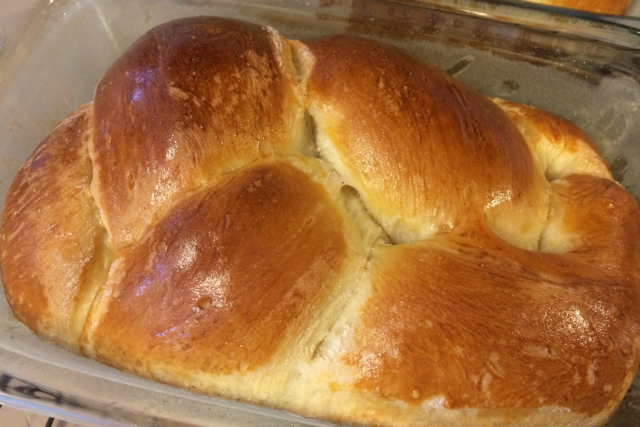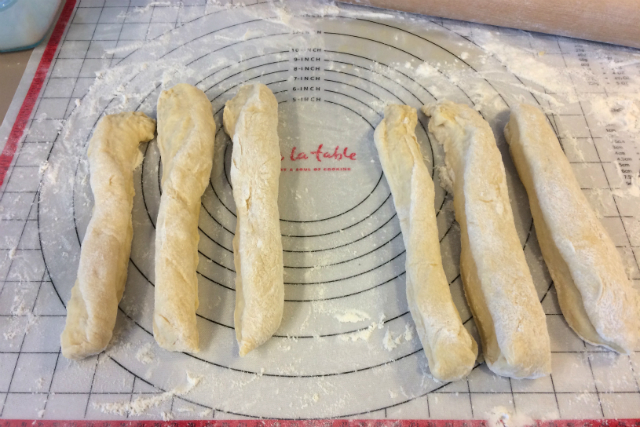Dad’s Greek Bread Adventure
During my first spring living in Colorado, I opened a box that my dad had overnighted from Vermont. After opening the flaps, I breathed in the most glorious smell of fresh Greek bread. Dad sent me two of the precious loaves he’d made.
Our family’s recipe for Greek bread makes four loaves or one large braided vasilopita — a special New Year’s version covered in powdered sugar that hides a lucky coin. When my mom typed it up ages ago, the recipe spanned multiple pages. Since then, more notations emerged.
I’d never attempted it. This holiday season, however, I asked Dad to teach me how. This lesson would be his present to me. So, on my birthday, we got to work.
The recipe calls for mastiha, a special Mediterranean tree resin that’s slightly woody and sweet smelling. Its flavor has pine and citrus undercurrents. A little goes a long way.
Over the years, Dad has perfected his bread. The result is a brioche-like crumb with a subtle mastiha flavor. The birthday bread Dad showed me how to make turned out wonderfully. Our Christmas Eve tradition is lightly toasting the slices, spreading on a little salted butter, and enjoying the bread with Metaxa-spiked eggnog. Leftover slices freeze well and can go directly into the toaster later.
Mastiha crystals, often called “tears,” can be purchased online or from some Greek specialty stores. The trees grow in more than one place, but the Greek island of Chios (pronounced “hee-oh-ss”) is the most well known producer.
The mastiha flavor can fade over time. Dad found that storing the pieces in the fridge helps them last longer. He also urged me to get a dedicated mortar and pestle just for grinding mastiha. Even with careful cleaning, the mastiha smell often persists.
Other important tools: four 1.5-quart glass loaf pans, a glass 4-cup measure, a rolling pin, a pastry brush, and an enormous mixing bowl. Dad’s giant stoneware dough bowl — around 6.5 inches tall and 12.5 inches in diameter — originally came from the historic Williamsburg store, but they no longer sell it. I’ll spare you the days of fruitless searching for something similar that’s also remotely affordable.
Finally, I decided to mix the dough in the biggest glass bowl we have and then divide it evenly into two large glass mixing bowls for the first rise.
Now, before I tell you how the Greek bread turned out at altitude, you need to know that all of my previous efforts to make regular bread loaves here had failed. They were underdone or, in one case, probably fine but I cut into it immediately, thought it was raw, and then proceeded to over-bake the loaf.
Waiting for my Colorado Greek bread loaves to cool was nerve-wracking. I’d spent the better part of a Saturday on the project. The color wasn’t as deep brown as the Vermont ones, but they seemed done. At last, I cut through the fattest one. Inside was light and airy without a hint of rawness. We toasted the slices and savored each crumb. Dad had taught me well.
Nick’s Greek Bread (Tsouréki)
Makes 4 loaves
2 envelopes active dry yeast
½ C. water
½ lb. unsalted butter, plus more to grease pans
1¼ C. sugar + 1 Tbsp. granulated sugar
5 large eggs
2 C. whole milk
~10 C. all-purpose flour
½ tsp. ground mastiha
½ tsp. salt
Olive oil
Vegetable oil
Before starting, get out all the ingredients. Clean the kitchen counter or surface where you’ll be working.
Make the Dough: Put the ½ cup of water in a 4-cup glass measure and microwave on high for 40 to 50 seconds, or until the water reaches 105 to 115°F. You want the water warm but not too hot. Add the yeast and 1 tablespoon of sugar, and stir to dissolve. The mixture should start to foam. Set it aside.
Get out a medium saucepan. Cut the butter into smaller chunks. Make the milk mixture by combining the butter with the milk and the 1¼ cups of sugar in the saucepan. Heat on medium-low and stir occasionally until the butter is fully melted and the sugar has dissolved. Turn off the burner, and set the pan off the heat.
Using a mortar and pestle dedicated to mastiha, pulverize mastiha tears into powder starting with two pea-sized pieces. You want approximately ½ teaspoon. Discard any little pieces that resist becoming powder. Use a table knife to scrape the ground mastiha from the mortar and pestle onto a piece of waxed paper. (See below for cleaning instructions.)
Break four of the eggs into a mixing bowl and beat them lightly.
Pour the milk mixture into a giant mixing bowl. Once the milk is lukewarm, gradually sift in 4 cups of flour, stirring well with a sturdy wooden spoon. Add the ground mastiha, salt, beaten eggs, and the bubbly yeast mixture, continuing to stir.
Keep gradually sifting in more cups of flour one at a time, mixing with the wooden spoon. Stop adding flour when you can’t mix it in the bowl any more. The exact amount of flour hinges on all sorts of factors, but it’s generally fewer than 10 cups at sea level. I used 7 cups at altitude and probably should have gone with 7½.
Rub some flour on your hands and turn the dough out onto a floured surface. Knead the dough for several minutes or until you have a relatively non-sticky ball of dough, adding more flour as needed. Let it sit on the counter while you clean and dry the giant mixing bowl.
For the next part, you can use two of your largest glass, ceramic, or stoneware mixing bowls. Take a photo of the dough in each one prior to the first rise for comparison, especially if the bowls aren’t exactly the same size.
First Rise: Wipe the entire inside of the clean mixing bowl or bowls with a small amount of olive oil to prevent the dough from sticking. Gently put the dough or dough halves in the bottom of the bowl or bowls. Cover with a sheet of wax paper and a kitchen towel. Let the bread rise in a warm place until it is double in size, approximately an hour. Some ovens, including ours, have a “proof” setting that keeps the temperature at 100°F.
While the dough is rising, carefully grease and flour the four 1.5-quart glass loaf pans, making sure the flour reaches each top edge. Knock excess flour from one pan into the next to avoid wasting it.
Second Rise: Remove the dough from the bowl to a floured surface. Punch it down and knead briefly. Use a rolling pin to flatten the dough into a rectangle that is approximately 1 inch thick. If you’re using two bowls, use a sharp knife or bench scraper to cut the dough in half. For one giant bowl, cut it into quarters. Shape each piece into a rectangle and slice it into three long equal “strands.” Use your fingers to form each third into a cylindrical shape for braiding:
Braiding, step 1. Credit: Guillaume Lessard.
Pinch three dough “strands” together at one end to secure them:
Braiding, step 2. Credit: Guillaume Lessard.
Braid them in the traditional way, repeating the pattern twice. Then pinch the other end of the dough strands together. Tuck both pinched ends underneath the braided loaf and gently put it in one of the prepared pans. Repeat with the rest of the dough.
Braiding, step 3. I probably could have pinched the ends better, though. Credit: Guillaume Lessard.
Let the braided dough rise again, uncovered this time, in a warm spot until roughly doubled in size. It will probably rise above the pan edges.
Egg Wash: Put the yolk from the last egg in a small bowl and add about a teaspoon of water. Mix well with a fork.
When the loaves complete the second rise, lightly brush the tops of each one with the egg wash. Wipe any excess off the loaf pan top edges and handles.
Bake: Preheat the oven to 350°F. Bake the loaves uncovered for 10 minutes. Then cover them with tented aluminum foil, shiny side up, and lower the heat to 325°F. Bake for another 20 to 30 minutes. In our oven at altitude it took 35 minutes. The bread will be done when it appears golden brown all over.
Place the pans on a rack to cool for 15 minutes. Carefully remove the loaves from the pans — they should come out easily. Set them on racks to cool completely. You don’t want to store them while they’re letting off any steam. Give them a couple hours. Also let the pans cool down before cleaning them.
Store loaves in airtight plastic bags. Slice loaves prior to freezing.
Mortar and Pestle Cleaning: Fill the mortar about halfway up with vegetable oil. Let the pestle rest in it, and leave this while you continue working on the dough. Then wipe off the oil and wash both pieces well in warm soapy water.





